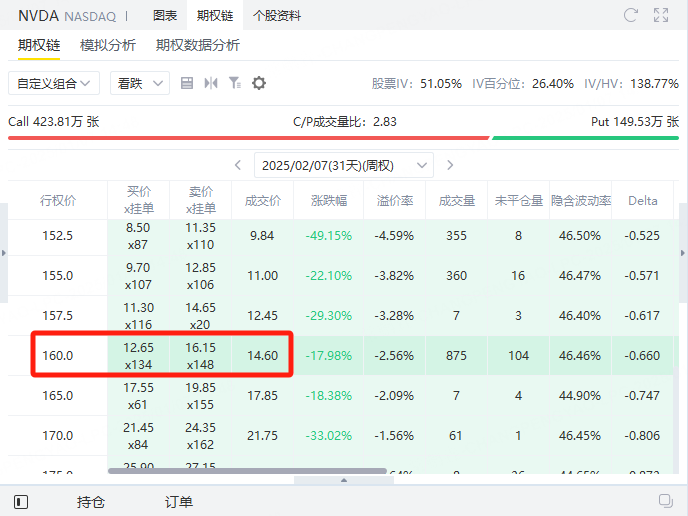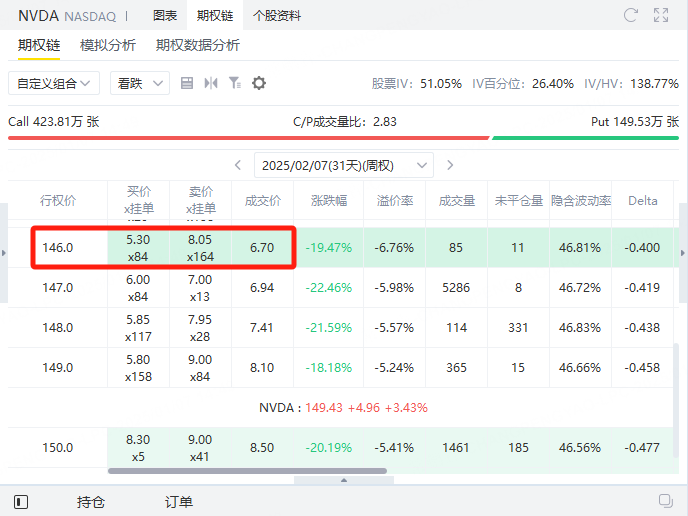NVIDIA Becomes a "Value Sweet Spot": How to Use Bull Put Spreads?
As the tech stock club welcomes new members, the nicknames for tech giants also evolve. Previously known as FANG, FAANG, or FAMANG, and recently as the "Magnificent Seven," these companies are now dubbed "BATMMAAN"—a group that includes $Broadcom (AVGO.US)$, $Apple (AAPL.US)$, $Tesla (TSLA.US)$, $Microsoft (MSFT.US)$, $Meta Platforms (META.US)$, $Alphabet-A (GOOGL.US)$, $Amazon (AMZN.US)$, and $NVIDIA (NVDA.US)$. All eight companies boast market capitalizations exceeding $1 trillion.
In 2024, BATMMAAN stocks achieved an average gain of 66%, far outperforming the 23% rise of the $S&P 500 Index (.SPX.US)$. Excluding these tech giants, the S&P 500 would have risen only 12%.
A Surprising Value: NVIDIA
As the new year begins, it’s an opportune moment for investors to reassess the valuation of these stocks. Surprisingly, NVIDIA, which delivered the most stellar performance in 2024, might be the only company that isn’t overvalued.
NVIDIA's stock price surged 171% in 2024, yet Wall Street analysts suggest the company is far from overvalued. The key lies in the PEG ratio—a metric popularized by legendary investor Peter Lynch that compares a company’s price-to-earnings ratio (P/E) to its expected earnings growth rate. While a P/E ratio measures how "expensive" a stock is relative to earnings, the PEG ratio adds more context. Lynch considered stocks with PEG ratios below 1 to be undervalued, while those above 1 might be overvalued.
At the end of 2024, NVIDIA’s P/E ratio was 31, based on 2025 earnings estimates, with analysts forecasting a 52% earnings growth rate for the year. This gives NVIDIA a PEG ratio of 0.6, the lowest among BATMMAAN, indicating significant investment potential.
At the other end of the spectrum, Tesla’s PEG ratio is 3.2, the highest in BATMMAAN. Tesla’s stock rose 63% in 2024, but its projected 2025 P/E ratio of 121 far exceeds its anticipated earnings growth rate of 37%.
Broadcom was the second-best performer in BATMMAAN, gaining 108% in 2024. Analysts forecast a 28% earnings growth rate for 2025, giving Broadcom a P/E ratio of 35 and a PEG ratio of 1.3, the second-lowest after NVIDIA but still indicating overvaluation.
Microsoft was BATMMAAN's worst performer in 2024, with a mere 12% stock price increase, trailing the S&P 500. Although some investors consider it undervalued, analysts predict only a 13% earnings growth rate for 2025, resulting in a PEG ratio of 2.3, suggesting its valuation is not cheap.
Meta and Alphabet have PEG ratios of 1.8 and 1.9, respectively, while Apple and Amazon’s PEG ratios are 1.8 and 1.4, respectively.
Cautions on PEG Analysis
This analysis relies on 2025 earnings forecasts, which are inherently uncertain. Additionally, the PEG ratio is only one dimension of valuation. Stock prices are also influenced by non-quantifiable factors such as investor sentiment. For example, Tesla's stock rally partly reflects CEO Elon Musk’s close ties with President-elect Trump. If their relationship sours or Trump’s policies fail to benefit Tesla materially, investor sentiment could shift—something no analytical model can predict.
Historical Perspective
High valuations don’t always translate to poor short-term performance. During 1998-1999, despite widespread warnings about overvaluation, the S&P 500 rose 21%. While valuation is a critical tool for long-term investors, overreliance on it could mean missing short-term gains.
NVIDIA’s Opportunity and the Bull Put Spread Strategy
NVIDIA’s compelling valuation makes it a standout among tech giants. For investors looking to enter NVIDIA after its strong earnings, the Bull Put Spread strategy is worth considering.
Bull Put Spread Strategy
A bull put spread involves selling a put option while simultaneously buying another put option with the same expiration date but a lower strike price (on the same underlying asset). Since the premium from the sold put is higher than the cost of the purchased put, this strategy generates a net credit.
When to Use It:
You expect the stock price to rise modestly or remain stable.
You want to limit downside risk while earning premium income.
Example with NVIDIA
Sell a $160 strike put (expires February 7): Receive premium = $1460.
Buy a $146 strike put (expires February 7): Pay premium = $670.
Net Credit:
$1460 - $670 = $790 (maximum potential profit).
Maximum Loss:
Strike price difference ($160 - $146) × 100 shares - net credit = ($1600 - $790) = $810.
Breakeven Price:
$160 - $7.90 = $152.10 (if NVIDIA's stock price falls to $152.10, the strategy breaks even).
Profit and Loss at Expiration
Stock Price ≥ $160:
Both options expire worthless.
Investor retains the full premium of $790 (maximum profit).
$146 ≤ Stock Price < $160:
The sold $160 put will be exercised.
The purchased $146 put offsets some of the loss.
Profit decreases as the stock price falls, reaching breakeven at $152.10.
Stock Price < $146:
Both options are exercised, resulting in the maximum loss of $810.
Strategy Summary
This strategy is ideal for investors who believe NVIDIA's stock will stay between $146 and $160 or rise slightly. Compared to selling a naked put, the bull put spread limits potential losses while maintaining an attractive risk-reward ratio.
Disclaimer: Investing carries risk. This is not financial advice. The above content should not be regarded as an offer, recommendation, or solicitation on acquiring or disposing of any financial products, any associated discussions, comments, or posts by author or other users should not be considered as such either. It is solely for general information purpose only, which does not consider your own investment objectives, financial situations or needs. TTM assumes no responsibility or warranty for the accuracy and completeness of the information, investors should do their own research and may seek professional advice before investing.



